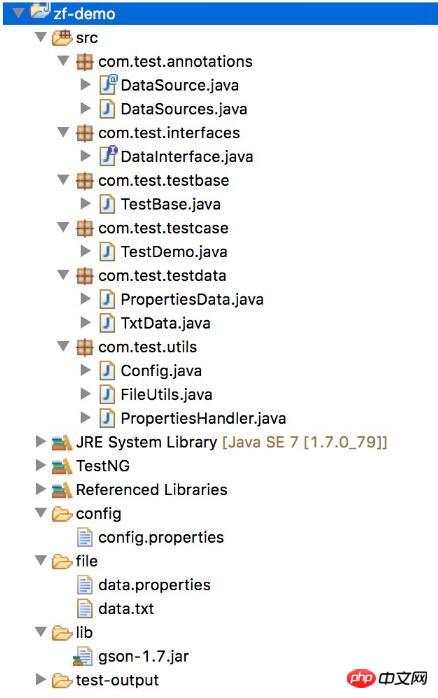Rumah >Java >javaTutorial >Java自动化测试中关于多数据源的切换详解
Java自动化测试中关于多数据源的切换详解
- 黄舟asal
- 2017-10-09 10:18:252220semak imbas
下面小编就为大家带来一篇Java自动化测试中多数据源的切换(实例讲解)。小编觉得挺不错的,现在就分享给大家,也给大家做个参考。一起跟随小编过来看看吧
在做自动化测试时,数据驱动是一个很重要的概念,当数据与脚本分离后,面对茫茫多的数据,管理数据又成了一个大问题,而数据源又可能面对多个,就跟在开发过程中,有时候要连接MYSQL,有时候又要连接SQL SERVER一样,如何做到快速切换?下面的示例中,我们将从一个数据源开始,一步步的演示下去:
一. 用外部文件做数据驱动的基本写法
1.1 我们在做数据驱动时,把数据存储在JAVA的属性文件中:data.properties
username=test password=123456
1.2 解析properties文件
public class PropertiesHandler {
private static Properties loadPropertiesFile(String filePath){
Properties p = new Properties();
InputStream in = null;
try {
in = new FileInputStream(new File(filePath));
p.load(in);
} catch (FileNotFoundException e) {
e.printStackTrace();
} catch (IOException e) {
e.printStackTrace();
}finally{
try {
if(in != null){
in.close();
}
} catch (IOException e) {
e.printStackTrace();
}
}
return p;
}
/**
* 将property转换成Map
* @param key
* @return
*/
@SuppressWarnings({ "rawtypes", "unchecked" })
public static Map<String, String> getPropertyData(String filePath){
try{
return new HashMap<String, String>((Map)PropertiesHandler.loadPropertiesFile(filePath));
}catch(Exception e){
e.printStackTrace();
}
return new HashMap<String, String>();
}
public static void main(String[] args) {
System.out.println(PropertiesHandler.getPropertyData("file/data.properties"));
}
}1.3 写一个TestBase类,里面用来存放TestNg的DataProvider
public class TestBase {
@DataProvider
public Object[][] dataProvider(){
return this.getTestData();
}
private Object[][] getTestData(){
PropertiesData testData = new PropertiesData();
List<Map<String, String>> listData = testData.getTestMethodData();
Object[][] object = new Object[listData.size()][];
for (int i = 0; i < listData.size(); i++) {
object[i] = new Object[]{listData.get(i)};
}
return object;
}
}可以看出,我只要有一个类,能够提供出一个数据类型为:Listfe497e2be29e556eda152481563466e6>的数据对象,就能够转换成Object[][]的二维数组,就能够提供给测试方法运行了。
1.4 在1.3中出现了一个PropertiesData类,现在来实现这个类
public class PropertiesData {
public List<Map<String, String>> getTestMethodData(){
List<Map<String, String>> list = new ArrayList<Map<String, String>>();
list.add(PropertiesHandler.getPropertyData("file/data.properties"));
return list;
}
}1.5 以上中有数据解析类,有数据加载类,有数据提供的基础类,于是我们再结合测试方法,把这三个基础类给融合在一起,就形成了一个外部文件来做数据源的完整示例了:
public class TestDemo extends TestBase{
@Test(dataProvider="dataProvider")
public void testDemo(Map<String, String> param){
System.out.println(param.get("username"));
System.out.println(param.get("password"));
}
}二. 属性文件换成txt文件的实现
2.1 如果有多个数据源,我想用txt来存放数据,txt里面存放一个json串:data.txt
{
"username":"test",
"password":"123456"
}2.2 读出这个txt文件
public class FileUtils {
public static String readFile(String fileName) {
InputStream is = null;
StringBuffer sb = new StringBuffer();
try {
is = new FileInputStream(fileName);
byte[] byteBuffer = new byte[is.available()];
int read = 0;
while((read = is.read(byteBuffer)) != -1){
sb.append(new String(byteBuffer, 0, read));
}
} catch (FileNotFoundException e) {
e.printStackTrace();
} catch (IOException e) {
e.printStackTrace();
}finally{
try {
if(is!=null){
is.close();
}
} catch (IOException e) {
e.printStackTrace();
}
}
return sb.toString();
}
public static void main(String[] args) {
System.out.println(FileUtils.readFile("file/data.txt"));
}
}2.3 将读取出来的JSON串进行解析(这里需要用到一个JAR包,gson.jar)
public class TxtData {
public List<Map<String, String>> getTestMethodData(){
List<Map<String, String>> list = new ArrayList<Map<String, String>>();
String data = FileUtils.readFile("file/data.txt");
Gson gson = new Gson();
Map<String, String> dataMap = gson.fromJson(data, new TypeToken<Map<String, String>>(){}.getType());
list.add(dataMap);
return list;
}
}2.4 将TxtData类给用上,即将TestBase类里的用到PropertiesData类的地方换成TxtData类即可
private Object[][] getTestData(){
TxtData testData = new TxtData();
List<Map<String, String>> listData = testData.getTestMethodData();
Object[][] object = new Object[listData.size()][];
for (int i = 0; i < listData.size(); i++) {
object[i] = new Object[]{listData.get(i)};
}
return object;
}2.5 运行TestDemo测试类后,发现结果与之前用PropertiesData类出现的结果一模一样。
三. 用接口来实现
3.1 上面的两种数据源,在把数据源里的内容给加载出来且加载出来的数据类型为:Listfe497e2be29e556eda152481563466e6>后,只需要把TestBase类里的数据源加载类给替换一个即可,那如此一来,我们可以利用JAVA里面的interface来重构我们的代码,首先当然得要有一个interface
public interface DataInterface {
public List<Map<String, String>> getTestMethodData();
}3.2 我们的PropertiesData类与TxtData类当然要实现这个接口了
public class PropertiesData implements DataInterface{
public List<Map<String, String>> getTestMethodData(){
List<Map<String, String>> list = new ArrayList<Map<String, String>>();
list.add(PropertiesHandler.getPropertyData("file/data.properties"));
return list;
}
}public class TxtData implements DataInterface{
public List<Map<String, String>> getTestMethodData(){
List<Map<String, String>> list = new ArrayList<Map<String, String>>();
String data = FileUtils.readFile("file/data.txt");
Gson gson = new Gson();
Map<String, String> dataMap = gson.fromJson(data, new TypeToken<Map<String, String>>(){}.getType());
list.add(dataMap);
return list;
}
}3.3 然后在TestBase里就要有所改变了,即产生数据加载的类对象要发生改变,我们在TestBase里新加一个方法(这是产生类对象的一种新的方式)
private DataInterface getDataInstance(String key){
DataInterface data = null;
try {
data = (DataInterface) Class.forName(key).newInstance();
} catch (InstantiationException | IllegalAccessException | ClassNotFoundException e) {
e.printStackTrace();
}
return data;
}3.4 TestBase类里的getTestData()方法就要重新的改变一下了
private Object[][] getTestData(){
DataInterface testData = this.getDataInstance("com.test.testdata.PropertiesData");
List<Map<String, String>> listData = testData.getTestMethodData();
Object[][] object = new Object[listData.size()][];
for (int i = 0; i < listData.size(); i++) {
object[i] = new Object[]{listData.get(i)};
}
return object;
}private Object[][] getTestData(){
DataInterface testData = this.getDataInstance("com.test.testdata.TxtData");
List<Map<String, String>> listData = testData.getTestMethodData();
Object[][] object = new Object[listData.size()][];
for (int i = 0; i < listData.size(); i++) {
object[i] = new Object[]{listData.get(i)};
}
return object;
}3.5 再次运行TestDemo,即可发现结果仍然是一样的。所以,这时候只需要改变数据加载类的路径即可了。
四. 将数据加载类的路径可配置化
4.1 这时候,我们就可以想着把数据加载类的路径写在配置文件中了config.properties
DataSource=com.test.testdata.TxtData
4.2 加载config文件
public class Config {
public static String DATA_SOURCE;
static{
Map<String, String> map = PropertiesHandler.getPropertyData("config/config.properties");
DATA_SOURCE = map.get("DataSource");
}
}4.3 将TestBase里的getTestData()方法再改进一下:
private Object[][] getTestData(){
DataInterface testData = this.getDataInstance(Config.DATA_SOURCE);
List<Map<String, String>> listData = testData.getTestMethodData();
Object[][] object = new Object[listData.size()][];
for (int i = 0; i < listData.size(); i++) {
object[i] = new Object[]{listData.get(i)};
}
return object;
}4.4 再次运行TestDemo类,结果仍然是一样的。到此为止,我们已实现了去更改配置文件里面的内容,来选择加载数据源。
五. 多数据源的切换
5.1 如果一个测试类里有两个测试方法,那么在配置文件里配置好数据源后,就表示这两个测试方法都将会加载同样的数据源,但如果我们希望一个测试方法用属性文件的数据源,另一个方法用TXT的数据源,这个如何办?也就是需要实现在全局配置化后,局部可再次选择数据源。我将会利用到JAVA里的注解,来实现。所以我们先定义一个DataSource的注解
@Target(ElementType.FIELD)
@Retention(RetentionPolicy.RUNTIME)
public @interface DataSource {
String value();
}5.2 解析该注解
public class DataSources {
public static String getDataSource(Method method){
DataSource ds = method.getAnnotation(DataSource.class);
if(ds != null){
return ds.value();
}
return null;
}
}5.3 该注解的使用
@DataSource("com.test.testdata.PropertiesData")
@Test(dataProvider="dataProvider")
public void testDemo(Map<String, String> param){
System.out.println(param.get("username"));
System.out.println(param.get("password"));
}5.4 TestBase类里的getTestData()方法再次的更改,要利用上这个注解解析出来的值
private Object[][] getTestData(Method method){
String sourceKey = DataSources.getDataSource(method);
if(sourceKey==null){
sourceKey = Config.DATA_SOURCE;
}
DataInterface testData = this.getDataInstance(sourceKey);
List<Map<String, String>> listData = testData.getTestMethodData();
Object[][] object = new Object[listData.size()][];
for (int i = 0; i < listData.size(); i++) {
object[i] = new Object[]{listData.get(i)};
}
return object;
}这段代码可以看到,如果测试方法标注DataSource,则会以标注的注解值为准,否则则会以全局配置的值为准。
5.5 在TestDemo里多加一个测试方法,以示区别
public class TestDemo extends TestBase{
@DataSource("com.test.testdata.PropertiesData")
@Test(dataProvider="dataProvider")
public void testDemo(Map<String, String> param){
System.out.println(param.get("username"));
System.out.println(param.get("password"));
}
@Test(dataProvider="dataProvider")
public void testDemo1(Map<String, String> param){
System.out.println(param.get("username"));
System.out.println(param.get("password"));
}
}上面的测试类中,两个测试方法,一个用了全局的配置数据源值,一个用了注解数据源值。大家可以运行的看看结果。
六. 工程结构图:

Atas ialah kandungan terperinci Java自动化测试中关于多数据源的切换详解. Untuk maklumat lanjut, sila ikut artikel berkaitan lain di laman web China PHP!
Artikel berkaitan
Lihat lagi- Subrentetan tetingkap minimum
- Mengecas Java dengan Projek Lombok: Permudahkan Kod Anda, Tingkatkan Produktiviti Anda
- Bagaimana untuk Memilih Kaedah Pengedaran Terbaik untuk Aplikasi Java Anda?
- Mengapa Memanggil `sleep()` pada Thread Dispatch Event Membekukan GUI?
- Enum sebagai Singleton dalam Java: Pembina Persendirian vs Kaedah Statik - Pendekatan Mana Yang Sesuai untuk Anda?

